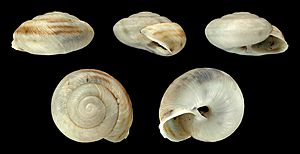Hemicycla mascaensis facts for kids
Quick facts for kids Hemicycla mascaensis |
|
|---|---|
 |
|
| Conservation status | |
| Scientific classification |
Hemicycla mascaensis is a special type of snail that lives on land. It belongs to a group of animals called gastropods, which includes snails and slugs. This snail is part of the Helicidae family, which are mostly land snails.
This unique snail is found only in Spain. It is endemic to the Canary Islands, meaning it naturally lives nowhere else in the world. Sadly, it is currently listed as Critically Endangered, which means it is at a very high risk of disappearing forever.
Contents
What is the Masca Snail?
The Hemicycla mascaensis is often called the Masca Snail because it was first found near Masca, a village on the island of Tenerife. Tenerife is one of the Canary Islands, which are part of Spain. This snail is quite small, like many land snails. It has a spiral shell that protects its soft body.
Snails are invertebrates, meaning they don't have a backbone. They move slowly on a muscular foot, leaving a trail of slime behind them. This slime helps them glide and protects them from drying out.
Where Does the Masca Snail Live?
The Masca Snail lives only in a very specific area on the island of Tenerife. It prefers damp, shady places, often found under rocks, leaves, or in cracks in the ground. These snails are important to their local ecosystem, helping to break down plant matter and recycle nutrients.
The Canary Islands have many unique plants and animals that are found nowhere else. This is because the islands are far from the mainland, allowing species to evolve differently over a long time. The Masca Snail is one of these special creatures.
Why is the Masca Snail in Danger?
The Masca Snail is Critically Endangered. This is the most serious category before a species becomes extinct. It means there are very few of these snails left, and they face many threats that could make them disappear completely.
Threats to its Survival
There are several reasons why the Masca Snail is in so much trouble:
- Habitat Loss: The places where the snail lives are being destroyed or changed. This can happen because of new buildings, roads, or changes in farming. When their homes are gone, the snails have nowhere to live or find food.
- Climate Change: Changes in weather patterns, like less rain or hotter temperatures, can make their habitat too dry for them to survive. Snails need moisture to live.
- Invasive Species: New animals or plants brought to the Canary Islands can harm the snails. Some new species might eat the snails, or they might compete for the same food and space.
- Small Population: Because there are so few Masca Snails left, it's harder for them to find mates and reproduce. This makes it very difficult for their numbers to grow.
How Can We Help?
Protecting the Masca Snail is very important. When one species disappears, it can affect the entire ecosystem. Here are some ways people are trying to help:
- Protecting Habitats: Efforts are made to protect the natural areas where the snails live. This means setting aside land where building and development are not allowed.
- Research: Scientists study the snails to learn more about their needs and how best to protect them. This includes understanding their diet, reproduction, and what makes them thrive.
- Awareness: Teaching people about the Masca Snail and why it's important to protect it helps gather support for conservation efforts.
By understanding and protecting unique creatures like the Masca Snail, we can help keep our planet healthy and full of amazing biodiversity for future generations.
Images for kids
See also
 In Spanish: Hemicycla mascaensis para niños
In Spanish: Hemicycla mascaensis para niños



